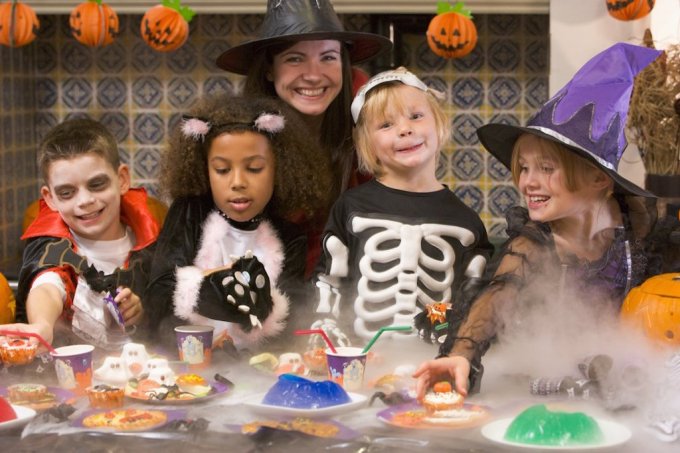 With Halloween around the corner, grocery stores are coming out with sugary treats to hand out to the neighborhood children. Sweets such as candy and chocolate are full of sugar, high in calories, and lack many nutrients that children need. Although purchasing these sugar-filled treats may seem like the routine tradition to do on Halloween, there are other more healthful treat options to hand out to your local trick-or-treaters. Encouraging your community to have a healthy Halloween can be fun for both you and the children!
With Halloween around the corner, grocery stores are coming out with sugary treats to hand out to the neighborhood children. Sweets such as candy and chocolate are full of sugar, high in calories, and lack many nutrients that children need. Although purchasing these sugar-filled treats may seem like the routine tradition to do on Halloween, there are other more healthful treat options to hand out to your local trick-or-treaters. Encouraging your community to have a healthy Halloween can be fun for both you and the children!
Be Creative With Food
 Healthy foods, such as fruits, can be made into fun Halloween-themed treats. Mandarin orange cups or tangerines can be drawn on to look like jack-o-lantern faces. Or, decorate a the wrapper of string cheese like a ghost. These healthy treats provide fun, hands-on activities for your children!
Healthy foods, such as fruits, can be made into fun Halloween-themed treats. Mandarin orange cups or tangerines can be drawn on to look like jack-o-lantern faces. Or, decorate a the wrapper of string cheese like a ghost. These healthy treats provide fun, hands-on activities for your children!
Use Non-Food Treats
 Who said Halloween treats need to be edible? Local stores have great, non-food alternatives in bulk at the same cost as candy. Candy is there one minute and gone the next, but this list of non-food treats will bring hours of fun for children!
Who said Halloween treats need to be edible? Local stores have great, non-food alternatives in bulk at the same cost as candy. Candy is there one minute and gone the next, but this list of non-food treats will bring hours of fun for children!
- Spider rings
- Halloween foam stickers
- Halloween-themed pencils
- Stretchy eyeballs
- Plastic fangs
- Halloween-themed erasers
- Halloween-colored yo-yos
- Plastic skeletons
Be Safe
 Safety precautions should be taken on Halloween. Non-food treats such as glow sticks can provide a safety feature for children to wear while they trick-or-treat in the dark. Lip-shaped whistles are a fun way to have a child let you know they are close by.
Safety precautions should be taken on Halloween. Non-food treats such as glow sticks can provide a safety feature for children to wear while they trick-or-treat in the dark. Lip-shaped whistles are a fun way to have a child let you know they are close by.
Find Healthy Substitutions
Sugar-filled treats can be substituted for nutritious treats at a low-cost. Instead of a pack of M&M’s, hand out packs of mixed nuts. Snacks such as air-popped popcorn, pretzels, and cheese sticks make great alternatives to candy items.
Non-Food Halloween Treats at Local Stores
Walmart: 27th & Superior Street
| Reward/Treat | Pieces per Pack | Price ($) |
| Stretchy Skeletons | 12 | 0.97 |
| Stretchy Eyeballs | 6 | 0.97 |
| Bat Rings | 50 | 0.97 |
| Foam Stickers | 75 | 0.97 |
| Spider Rings | 50 | 0.97 |
| Plastic Skeletons | 12 | 0.97 |
| Mini Erasers | 50 | 0.97 |
| Glitter Foam Stickers | 50 | 0.97 |
| Glow Bracelet | 5 | 0.97 |
| Plastic Fangs | 12 | 0.97 |
| Bounce Balls | 12 | 1.97 |
| Mini Gel Pens | 12 | 1.97 |
| Pencil Topper Stamps | 12 | 1.97 |
| Puzzle Mazes | 8 | 1.97 |
| Bubbles | 12 | 1.97 |
| Assorted pencils | 28 | 1.97 |
Dollar Store: 27th & Superior St.
| Reward/Treat | Pieces per Pack | Price ($) |
| Puffy Stickers | 47 | 1 |
| Skull Rings | 50 | 1 |
| Spider Rings | 50 | 1 |
| Assorted Pencils | 50 | 1 |
| Assorted Erasers | 18 | 1 |
| Assorted Erasers | 12 | 1 |
| Glow Bracelets | 8 | 1 |
| Assorted Stickers | Varies | 1 |
| Creepy Creatures | 12 | 1 |
| Yo-Yos | 8 | 1 |
| Lip Whistles | 6 | 1 |
| Spin- Tops | 8 | 1 |
Additional Resources & Links
This Pinterest board gives healthy ideas for Halloween fun.
Authors: Kelsey Doerr, Jaci Foged and Dipti Dev | The Learning Child
Make sure to follow The Learning Child on social media for more research-based early childhood education resources!
